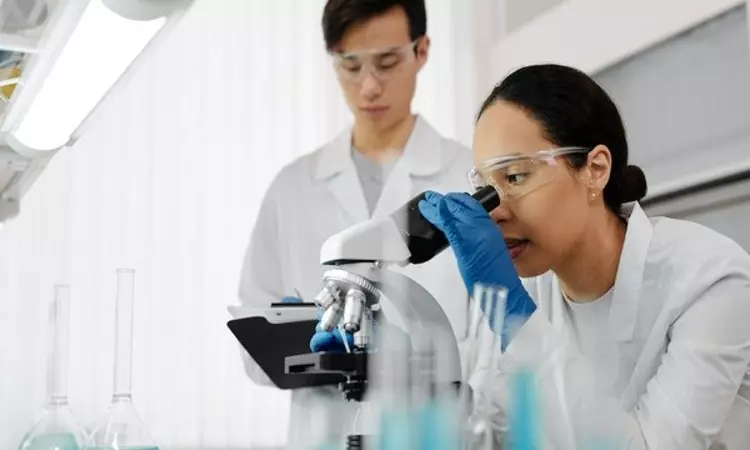Ion channel proteins can rearrange itself into bigger shape: Study
The finding provides the answer regarding peculiar characteristic of particular ion channels, and can improve design of medications for drug delivery.

Representative image
WASHINGTON DC: According to a study headed by researchers at Weill Cornell Medicine, a member of a significant family of Ion channel proteins can rearrange itself into a bigger shape with significantly different capabilities.
The finding represents a major advancement in cell biology, presumably provides the answer to a long-standing puzzle regarding a peculiar characteristic of particular ion channels, and has ramifications for the design of medications that target these proteins as well as for drug delivery.
In the cell membranes of higher species, ion channels are present almost everywhere. To control cell activity, they transport ions—small, charged molecules—into or out of cells. The majority of biological processes, including sensation, thought, and heartbeat, depend on them. The study, which was released in Nature, looked at the structural dynamics of the ion channel TRPV3. They found a rare but remarkable structural rearrangement in which TRPV3, ordinarily a "tetramer" consisting of four identical protein subunits, transforms into a five-protein "pentamer."
Strong proof was discovered by the researchers that this structural change is responsible for the previously unrecognised ion-channel phenomena known as pore dilation. "These findings open up a broad new avenue of research on the workings of ion channels," said study senior author Dr. Simon Scheuring, a professor of physiology and biophysics in anesthesiology at Weill Cornell Medicine.
Dr. Shifra Lansky, a postdoctoral research associate in the Scheuring lab in the Department of Anesthesiology, was the study's primary author. The project was carried out in cooperation with the lab of Dr. Crina Nimigean in the Weill Cornell Medicine Department of Anesthesiology. The body uses the ion channel TRPV3 to sense warm temperatures, maintain healthy skin, relieve itch, promote hair development, and perform other tasks. It is a member of the wider TRP ion channel family, which is responsible for a wide range of biological functions in higher species.
Using a cutting-edge technique called high-speed atomic-force microscopy, Dr. Scheuring and Lansky and their associates initially set out to map TRPV3's structural dynamics—how its structure changes as it opens and shuts its channel. TRPV3, which is typically a tetramer, can occasionally combine into a pentamer, which can only persist for about three minutes, as the researchers quickly learned to their astonishment.
The researchers understood that the phenomena of ion channel pore dilation, which was initially noted in another ion channel in 1999 and in TRPV3 in 2005, may be explained by this significant enlargement of the TRPV3 structure. When an ion channel opens abnormally, admitting significantly larger ions than usual, and loses sensitivity to its typical activators and inactivators, this is known as pore dilatation.
This uncommon, temporary state is rare. Although pore dilation can be caused by prolonged ion channel activation, the researchers believe it acts as a defense mechanism against overexposure to a stimulus. It is unclear whether pore dilation serves an evolved biological function. "If you bite on a strong chili pepper, for example, your mouth will be insensitive and in pain for a few minutes, during which you won't want to take another bite," Dr. Scheuring said. "Maybe that kind of protective alteration of sensitivity is what ion channel pore dilation is for."
Drug developers are especially interested in pore dilation because it can sometimes be therapeutically beneficial to suppress it, and because activating it may make it possible to enter cells that would otherwise be impervious to large, water-soluble drug molecules. The team then obtained a high-resolution 3D structure of pentameric TRPV3 using electron microscopy. They demonstrated that the pore of the TRPV3 pentamer is, in fact, significantly larger than the pore of the tetramer, which is consistent with higher ion conductance and molecular transport.
These characteristics are linked to the phenomena of pore dilation. Additionally, they discovered that a substance known to increase pore dilatation destabilises the TRPV3 tetramer, increasing the likelihood that it will transform into a pentamer by nearly twofold. They came to the conclusion that this temporary pentameric configuration of usually tetrameric ion channels is associated with pore dilatation.
As pore dilation has been functionally reported in at least seven channels from two different families, it appears to be a characteristic of many ion channels. As a result, the discovery is anticipated to spur extensive additional research in this field with the aim of elucidating how pore dilation occurs and how it can be controlled, possibly for the treatment of diseases.
"There are genetic diseases linked to mutations in TRPV channels, and we suspect that some of these mutations cause disease by increasing pentamer formation," Dr Lansky said. "If we can prove that, it would be a big step towards curing these diseases."



